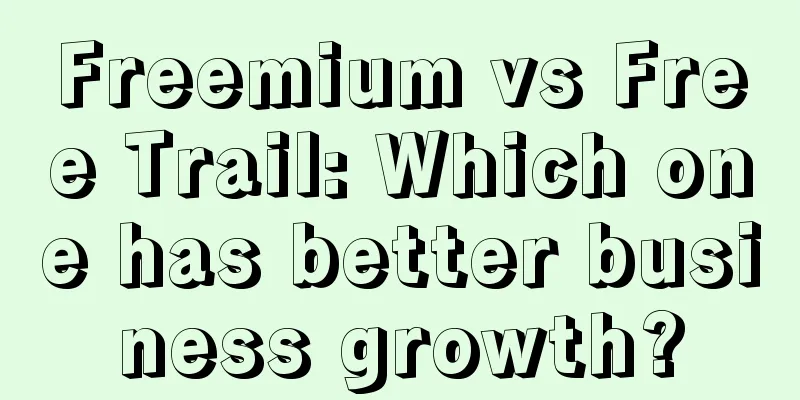Freemium vs Free Trail: Which one has better business growth?

At the beginning of the development of the Internet industry, due to its low marginal cost, it was often known for being free, and it lost money to gain publicity. After more than 20 years of ups and downs, after the high growth rate slowed down, "free first, paid later" became a better business solution. For example, Duolingo, a learning platform with over 100 million monthly active users and continuously growing revenue; Spotify, the music streaming giant; and Slack, the fastest-growing SaaS tool in history, all use this solution. When deciding on a product business model, do you prefer a freemium model or a free trial model? This article will explore the pros and cons, decision-making basis, and success cases of the Freemium and Free Trail models (with AIGC product examples) to help you understand and choose the product model that suits you. Whether you are an entrepreneur, product manager, or marketer, you can get valuable information. Without further ado, let's go straight to the main text. Enjoy: 1. What is Freemium?Freemium was first proposed by Fred Wilson of AVC in 2006. It refers to attracting users with free services , and then converting some free users into paid users through value-added services to realize monetization. In the Freemium model, 90-95% of the content is free, and 5-10% of the content is charged. Following the "80/20 rule", a small number of high-end users who are not sensitive to price bring most of the revenue to the service provider. Although Internet companies have high initial investment costs, their service marketing costs are almost zero, so the profits earned from paid services can quickly make up for their investment in free services and acquiring new users. Under the Freemium model, companies usually adopt the following strategies to achieve business growth:
For example, on the Duolingo language learning platform, free users can use learning tutorials, but more value-added services require purchasing a membership. Advantages and Disadvantages of the Freemium Model1) Advantages
2) Disadvantages
2. What is Free Trial?Free Trail is common in SaaS products, which means allowing users to try their products or services for free for a limited time . The goal of this model is to attract users by providing a trial experience and hope to convert them into paying users at the end of the trial period. When implementing the Free Trail model, companies typically take the following approach:
For example, on the NetEase Cloud Commerce SaaS platform, users can apply for a limited 7-day free trial, during which they can try out most of the platform's core functions. After the trial period, they will need to pay to continue using the functions. Advantages and disadvantages of Free Trail mode1) Advantages
2) Disadvantages
3. Which company has the strongest business growth?1. Difference: Both growth models have their own advantagesAlthough both Freemium and Free Trail focus on free, there are still differences in product design (trial period, payment and functional restrictions) and core business indicators (registration rate, payment conversion rate).
There are no standard answers to these more detailed questions, but they can be gradually optimized in growth experiments . After all, growth is not achieved overnight, but requires constant adjustment and polishing of each link to get the flywheel turning. 2. Decision-making: How to choose between different industries and product typesWhen deciding on a product business model, do you prefer a freemium model or a free trial model? You may want to make a judgment based on the industry, product type, and market strategy , which may make your choice easier. Industry characteristics and product types are easy to understand. Here is a further explanation of how “market strategy” drives decision-making:
3. Case: Standing on the shoulders of giants1) Spotify - the world's largest music streaming platform Spotify is a streaming music platform that adopts the Freemium model. It provides free music streaming services, allowing users to access the music library without restrictions with advertisements. This enables Spotify to attract a large number of users and build a strong community effect. At the same time, Spotify also offers a paid version, called Spotify Premium, in which users can enjoy advanced features such as no ads, offline playback and high sound quality.
2) Microsoft Office 365 - the leader in office tools for 12 years Microsoft Office 365 is a cloud office suite that uses the Free Trail model. It provides a 30-day free trial period, where users can experience the full range of Office applications and cloud services for free. After the trial period, users need to purchase a subscription plan to continue using it.
3) AIGC - the rising stars ready to take off Last year, AIGC products represented by ChatGPT and Midjourney emerged, setting off a new wave of AI technology transformation around the world and giving entrepreneurs a new impetus: reducing technology development and operating costs and meeting customers' personalized needs. As the AIGC wave sweeps the world, it is not difficult to find that a large number of products also adopt the Freemium and Free Trail models, bringing disruptive growth. Freemium: ChatGPT is a large-scale language model developed by OpenAI. In just 2 months, the number of active users has exceeded 100 million, and there are now more than 2 billion users. ChatGPT 3.5 and previous versions are free to use, and after the model is upgraded, the official monthly subscription fee for ChatGPT-4 plus is US$20, and API calls are charged separately based on response time. Free Trail: Midjourney is a gold medal player in the Vincent Image track, achieving 10 million users and $100 million in revenue in less than a year. Midjourney adopts a SaaS subscription model, with prices ranging from $10 to $60 per month. However, before paying, Midjourney provides free users with a limited-time trial opportunity. Domestic AIGC products also adopt a similar model, such as Wenxin Yige, Doubao and other products, which acquire customers for free to seize the initiative and achieve business growth by converting product value. 4. Final ThoughtsFreemium VS Free Trail, disruptive growth is on the left, differentiated growth is on the right. The Freemium model is suitable for industries that achieve network effects by building a large user base, while the Free Trail model is suitable for industries that require users to have sufficient time to evaluate the value of the product. In addition to industry type , when choosing a suitable business model, companies also need to comprehensively consider factors such as product characteristics, target users, market competition and profit model . Regardless of which model is chosen, companies need to ensure that the free version or trial period provides sufficiently attractive features , while providing more advanced features and value-added services in the paid version , and at the same time provide good transition guidance to attract users to smoothly upgrade to paid users. The above is the content of "Freemium VS Free Trail Business Growth Analysis", which is based on user growth work practice & research. If you have any good insights, please leave a comment in the comment area below. |
>>: Behind Huaxizi’s PR failure: Why does the boss always distrust his own PR team?
Recommend
Studying Chinese culture is really profitable!
This article tells us that Chinese studies are act...
After talking with several emerging brands, we summarized three directions and 10 suggestions for reducing costs and increasing efficiency.
"The situation this year is that the wealthy ...
How does Shopee short video operate? Introduction to the reward mechanism
Shopee Video (SV) is a short video content section...
Signing Messi and appearing on the Spring Festival Gala, will Jitu's huge marketing expenses go to waste?
Starting in a foreign country, and carving out a n...
Can Amazon Europe force KYC? How to trigger KYC?
If you do business with Amazon in Europe, the UK i...
Zhuang Jun: After analyzing 1,000 popular articles on Xiaohongshu, I summarized these routines!
As a lifestyle sharing platform, Xiaohongshu not o...
How to optimize Amazon listings? Basic optimization guide
The main purpose of Listing basic optimization is ...
Is Shopee's e-commerce profitable? What are the benefits?
As the next batch of platforms continue to grow, m...
Live streaming sales, godfathers everywhere
The live streaming industry is undergoing profound...
What does Amazon sku mean? What are the Amazon sku coding rules?
Amazon is the most popular cross-border e-commerce...
What questions do you have about joining Shopee? FAQ
The first step to becoming a Shopee seller is to s...
How to start a business on Douyin from scratch?
This article shares the principles of the Douyin s...
Six questions for the brand’s first offline store: Are you prepared for three years of no profit?
...
The year-end explosion, Douyin's fan growth list returns to the "million era"
As the year comes to an end, Douyin has once again...
What are the conditions for registering a Shopee online store? How much does it cost?
Shopee is a good cross-border e-commerce platform,...









